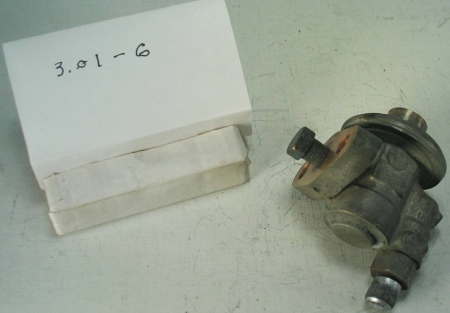Refrigerant Flow Controls – Household
A mid 20th century, compact, spring compensated, adjustable, automatic expansion valve for use on “dry evaporators”, with tin coated, cast brass body, flange mounting and wrench pads, finely calibrated and rated for sulphur dioxide, methyl chloride and Freon 12 refrigerant [Incomplete Assembly] Automatic Products, Model AP204, circa 1944.
Original manufacturer’s installation and service instruction sheet; Inlet screen; Moisture proof, more robust metal cap and seal [not included]
Technical Significance
An example of the new generation of compact, more precisely engineered and performing expansion valves emerging early in the 1940’s, calibrated and engineered the wider range of refrigerants then in use, including mainly sulphur dioxide, menthol chloride and Freon 12
Dramatises the major gains made by the industry over a period of less than 10 years, during a period of feverish research and development using the scant knowledge and experience available to workers in the field at the time, compare ID # 165 to 173
This artifact of history tells the many stories of early adoption of this particular fluid flow technology, the automatic expansion valve. After a brief flurry of excitement over the use of more costly and delicate float operated devices, as a more efficient means of flow control, industry engineers would return to the automatic expansion valve in the early 30’s. But by then the automatic expansion valve would be a smaller and much more precisely calibrated and efficient device. While the automatic expansion valve was less efficient in its effective use of evaporator surface than high and low side float systems [See HHCC Series 3.01 artifacts, ID # 175 and 176 for example], it had the advantage of reliability, maintainability and affordability, as well as serviceability.
Industrial Significance:
Following W.W.II, in the 1940’s, the refrigeration and air conditioning industry went through a second major growth spurt. By then it was armed with new technology, manufacturing and engineering know-how, as well as new materials to work with – much of it the results of war-time research, development and field practice.
This valve in many ways characterizes the world change that had taken place, encouraging, allowing and facilitating many new refrigeration and air conditioning applications. These were especially evident in the emergence of sophisticated “packaged systems”. Using the new chlorinated hydrocarbon refrigerants [e.g., Freon 12], the systems were smaller more compact, quieter and more user friendly.


